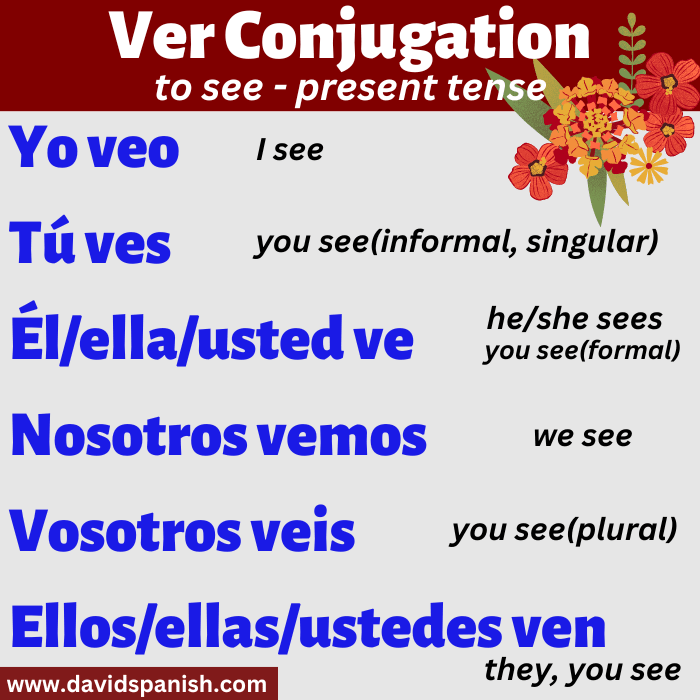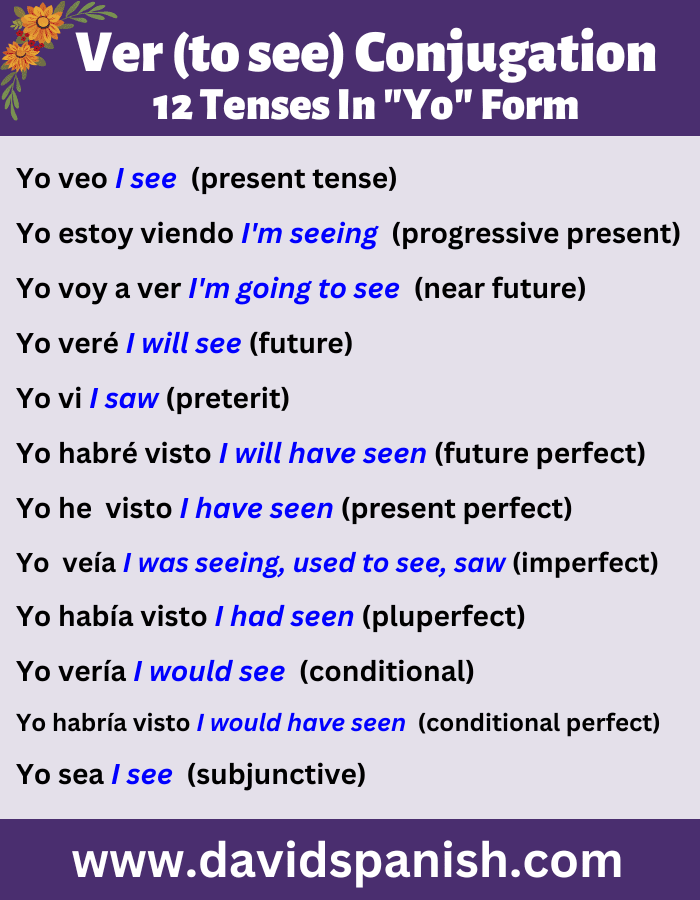Ver (Meaning: to see) is an essential verb for all students. The conjugation of ver in the present tense is: Yo veo (I see), tú ves (you see), él/ella/usted ve (he/she sees; you see), nosotros vemos (we see), vosotros veis (you see) and ellos/ellas/ustedes ven (they see; you see).

Ver is an irregular ER verb. This means aspects of its stem and endings when conjugated in the present tense are different than other regular ER verbs. This page on our site covers both regular and irregular Spanish ER verbs in detail.
Verb conjugation in the present tense

Further down this page we’ve provided conjugation charts for ver with example sentences in the following eight major verb tenses:
- Present tense (presente de indicativo)
- Near future (futuro inmediato)
- Future tense (futuro)
- Preterite (pretérito)
- Present perfect indicative (perfecto de indicativo)
- Imperfect (imperfecto de indicativo)
- Conditional (potential simple)
- Present subjunctive (presente de subjuntivo)
Verb conjugation table

Ver conjugation in a nutshell
The following graphic shows conjugations for ver in the first-person singular (yo) form in twelve verb tenses.

Ver conjugation charts
Present tense (presente de indicativo)
In the present tense, yo veo translates to both “I see” and “I am seeing”.
| yo veo | I see | Yo veo la montaña. | I see the mountain. |
| tú ves | you see | Tú ves el océano. | You see the ocean. |
| él/ella, usted ve | he/she sees, you see | Ella ve las estrellas. | She sees the stars. |
| nosotros vemos | we see | Nosotros vemos a los niños. | We visit the kids. |
| vosotros veis | you see | Vosotros veis los árboles. | You see the trees. |
| ellos/ellas, ustedes ven | they/you see | Ellos ven la película. | They're watching the movie. |
Near future (futuro inmediato)
The Spanish near future tense is formed with the following construction: ir (to go) in the present tense + preposition a + infinitive. Yo voy a ver transaltes to “I am going to see”.
| yo voy a ver | I am going to see | Voy a ver un obra de teatro. | I'm going to see a play. |
| tú vas a ver | you are going to see | Tú vas a ver el espectáculo. | You're going to see the show. |
| él/ella, usted va a ver | he/she is going to see, you are going to see | Él va a ver una exhibición. | He's going to see an exhibition. |
| nosotros vamos a ver | we are going to see | Nosotros vamos a ver un musical. | We're going to see a musical. |
| vosotros vais a ver | you are going to see | Vosotros vais a ver un concierto. | You are going to see a concert. |
| ellos/ellas, ustedes van a ver | they/you are going to see | Ellos van a ver una presentación. | They're going to see a performance. |
Future tense (futuro)
In the Spanish future tense, yo veré translates to “I will see”.
| yo veré | I will see | Yo veré si sea posible. | I'll see if it's possible. |
| tú verás | you will see | Algún día tú verás la verdad. | Someday you'll see the truth. |
| él/ella, usted verá | he/she/you will see | Él verá si ella pueda venir. | He'll see if she can come. |
| nosotros veremos | we will see | Nosotros veremos quién viene a la fiesta. | We'll see who's coming to the party. |
| vosotros veréis | you will see | Vosotros veréis a mucha gente. | You'll see a lot of people |
| ellos/ellas, ustedes verán | you/they will see | Ellos verána a todos sus familiares. | They'll see all their relatives. |
Preterite (pretérito)
The preterite is a commonly used past tense used to express past actions which occurred at defined times. Yo vi translates to “I saw”.
| yo vi | I saw | Yo vi la película. | I saw the movie. |
| tú viste | you saw | Tú viste la serie. | You saw the TV series. |
| Él/ella, usted vio | he/she/you saw | Él vio el obra de teatro. | He saw the play. |
| nosotros vimos | we say | Nosotros vimos el concierto. | We saw the concert. |
| vosotros visteis | you saw | Vosotros visteis la exhibición de Van Gogh. | You saw the Van Gogh exhibition. |
| ellos/ellas, ustedes vieron | you/they saw | Ellos vieron la orquesta. | They saw the orchestra. |
Present perfect indicative (perfecto de indicativo)
The present perfect is another commonly used past tense which is used to express past actions which may have a bearing on the present. Yo he visto translates to “I have seen”.
| yo he visto | I have seen | No he visto el espectáculo. | I haven't seen the show. |
| tú has visto | you have seen | ¿Has visto a Pablo? | Have you seen Pablo? |
| él/ella, usted ha visto | he/she has seen; you have seen | Ella todavía no ha visto la serie. | She still hasn't seen the TV series. |
| nosotros hemos visto | we have seen | Nosotros hemos visto el concierto dos veces. | We've seen the concert twice. |
| vosotros habéis visto | you have seen | ¿Habéis visto a los primos? | Have you seen the cousins? |
| ellos/ellas, ustedes han visto | they/you have seen | Ellos no han visto la exposición. | They haven't seen the exhibition. |
Imperfect (imperfecto de indicativo)
The imperfect tense is used to express past actions which occurred over time. Yo veía translates to “I used to see”, “I was seeing” and “I saw”.
| yo veía | I used to see, was seeing, saw | Cuando ere niño, veía a mis abuelos todos los años. | When I was a child, I used to see my grandparents every year. |
| tú veías | you used to see, were seeing, saw | Cuando vivías a Madrid, veías rara vez a sus padres. | When you were living in Madrid, you rarely saw your parents. |
| él/ella, usted veía | he/she (you) was (were) seeing, used to see, saw | Ella veía a sus primos de vez en cuando. | She used to see her cousins from time to time. |
| nosotros veíamos | we were seeing, used to see, saw | Nosotros veíamos a nuestros nietos cada Navidad. | We used to see our grandchildren every Christmas. |
| vosotros veíais | you used to see, were seeing, saw | Vosotros veíais a vuestros parientes cada verano. | You used to see your relatives every summer. |
| ellos/ellas, ustedes veían | they/you were seeing, used to see, saw | Ellos veían a sus compañeros de clase durante las vacaciones. | They used to see their classmates during vacation. |
Conditional (potential simple)
The conditional tense is used to express hypothetical actions. Yo vería translates to “I would see”.
| yo vería | I would see | Yo vería la película si tuviera más tiempo. | I'd see the movie if I had more time. |
| tú verías | you would see | Tú verías a tus primos si vivieran de esta ciudad. | You'd see your cousins if they lived closer to this city. |
| él/ella, usted vería | he/she/you would see | Ella vería el concierto si estuviera libre esta noche. | She's see the concert if she were free tonight. |
| nosotros veríamos | we would see | Nosotros veríamos a la exhibición si los boleto estuvieran en venta. | We'd see the exhibition if the tickets were on sale. |
| vosotros veríais | you would see | Vosotros veríais la serie si tuvierais un televisor. | You'd watch the series if you had a TV set. |
| ellos/ellas, ustedes verían | they would see | Ellos verían a sus amigos si vivieran en este país. | They'd see their friends if they lived in this country. |
Present subjunctive (presente de subjuntivo)
The subjunctive mood is used to express wishes, emotions and doubts. Yo vea translates to “I see”.
| yo vea | I see | Queire que yo vea la película. | He wants me to see the movie. |
| tú veas | you see | Es importante que veas a tu cuñado. | It's important that you see your brother-in-law. |
| él/ella, usted vea | he/she sees, you see | Es una lastima que ella no vea la serie. | It's a shame she's not watching the series. |
| nosotros veamos | we see | Es necesario que nos veamos hoy. | It's necessary that we see each other today. |
| vosotros veáis | you see | Es dudoso que veáis la verdad. | It's doubtful that you're seeing the truth. |
| ellos/ellas, ustedes vean | they/you see | Es fantástico que ellos el concierto. | It's fantastic that they're seeing the concert. |
Discover more:
- Ser vs. estar explained
- Ser (to be) conjugation charts
- Hablar (to speak) conjugation charts
- Tener (to have) conjugation charts
- Querida – Lyrics, Meaning & Translation - May 2, 2024
- Reflexive Verbs In Spanish: Everything You Need To Know - April 7, 2024
- Cielito Lindo Lyrics, Meaning & Translation - November 24, 2023
